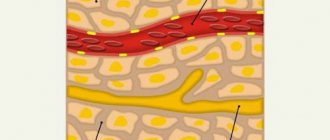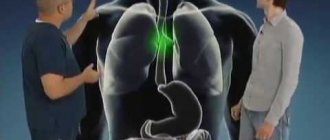Make an appointment The problem of hemorrhoids is quite common among people. It accounts for 35–40% of all rectal diseases. Ligation of hemorrhoids allows you to cope with it in 85% of cases.
Due to genetic predisposition, a sedentary lifestyle, and dietary habits, dilation of the veins of the hemorrhoidal plexus occurs in the anus. They take on the appearance of nodes: they are enlarged, painful, and blood clots can form in them. A person suffering from hemorrhoids notes prolapse of the nodes outside the rectum, which requires their reduction. When injured, they bleed, can become inflamed, and when pinched, ischemia and necrosis develop. With a long course of the disease, the surrounding intestinal mucosa suffers. It can ulcerate, become inflamed, and with frequent bleeding, anemia develops.
Treatment, removal of hemorrhoids - profile of the Alan Clinic medical center. Contact our specialists.
Ligation of hemorrhoids: in what cases is it prescribed?
For internal hemorrhoids (nodes located above the level of the dentate line) stages 1, 2, and less often 3 without complications, ligation of hemorrhoids can help. For external hemorrhoids and complicated forms, other methods are chosen.
This minimally invasive procedure does not require pain relief or hospitalization; the person returns home on the first day and can resume normal activities in 2–3 days. In 1 procedure, 1–2 nodes are removed. If there are more of them, a repeat session is scheduled after 2 - 3 weeks (after complete healing).
additional information
How long is the recovery period? Latex knot ligation attracts many precisely because it allows you to quickly get to work.
In one manipulation you can solve a problem with one or two nodes. Ligating more cones at the same time can cause complications. Each subsequent manipulation is performed on average 7-10 days after the previous one.
Latex doping of hemorrhoids is not suitable for some patients. Contraindications may include:
- diseases of the circulatory system;
- fourth stage of the disease;
- Proctological diseases - paraproctitis, proctitis - in the acute stage.
Removal of hemorrhoids with rings: pros and cons
Benefits of removing hemorrhoids with latex rings:
- Compared to rectal surgery, this procedure is quick, painless, does not require anesthesia, is bloodless, and has a minimal recovery period.
- Compared to drug treatment, it effectively eliminates the node itself and the phenomena associated with it.
- Hemorrhoid rings do not cause allergies or irritation, are not rejected by body tissues, and leave the body naturally when the node itself dies.
The disadvantage of treating hemorrhoids with rings is that in 30% of cases relapses are possible within 3 or 5 years. If the provoking factors are not eliminated - congestion in the pelvis, a sedentary lifestyle, a tendency to constipation, spending a long time in a sitting position, stress - the disease will manifest itself again.
Also, this method will not help in advanced cases: with multiple large nodes, if they cannot be adjusted, or if they are pinched. In case of severe inflammation, the severity of the process must first be relieved with medications.
Dressing technique
P.k.s. carried out in the wound and throughout. In the wound, larger vessels are ligated individually, small ones - by applying a Z-shaped or purse-string suture, capturing the surrounding tissue, or the bleeding is stopped by diathermocoagulation. In particular, with laparotomy, thoracotomy and certain other approaches P. to. combined with diathermocoagulation. P.k.s. throughout most often it is a forced technique when it is not possible to perform P. k.s. in the wound. This usually happens with severe bleeding in an infected wound or with arrosion of a vessel. To expose the vessels along their length, typical approaches are used; the vascular bundle is widely exposed. Isolation of vessels is carried out using scissors and a dissector or other type of clamps. Blood is first removed from the wound with tampons and napkins, or better with suction, after which the crossed blood vessel becomes visible.
With a typical version of P. c.s. The end of the vessel is grabbed with a clamp, without separating it from the surrounding tissue. The assistant lifts the clamp upward, and the surgeon places a ligature under it (see), making sure to bypass the end of the clamp with the ligature (in a deep wound, it is sometimes more convenient to bring the thread under the hemostatic clamp using another clamp or a special tool such as a fork), and ties the first knot. Then the assistant removes the hemostatic clamp, and the surgeon, after further tightening the first knot, ties the second. When using synthetic thread, you need to tie 3-5 knots.
Second option P. c.s. used, for example, during gastric resection, when it is necessary to cross the lesser omentum. Two clamps are applied to the seal area, and it is crossed between them; the vessels along with the omental tissue are ligated (usually with suturing of the omentum). That's the same option' P.k.s. possible with intestinal resection, etc.
Rice. 1. Schematic representation of the vessel ligation along its length: a double ligature is placed under the selected vessel.
Third option P. k.s. most often used for ligation of large vessels. In these cases, the vessel (vein or artery) is first isolated and placed under it using a dissector (Fig. 1) and two ligatures are tied, between which the vessel is crossed. In the same way, the vessel can be crossed between two clamps and its ends tied. When ligating large vessels, for reliability, it is better to tie each end with two threads, and apply the second ligature with stitching with an atraumatic needle. Other options for ligating large vessels are also possible. Thus, ligation of a thin-walled vessel can be done by first applying a U-shaped or simple suture using an atraumatic needle, capturing the outer shell of the vessel. In cases where the vessel wall is sharply thinned and the ligature can easily cut through it, Teflon felt gaskets are used when suturing the vessel.
If the aorta or large great vessels are damaged, a vascular suture (see), applied with an atraumatic needle, and vascular reconstruction are used. In the case of severe calcification of the vessel, sutures are placed through the outer membrane and around the entire circumference of the vessel, then tied. If it is impossible to perform these operations during the initial treatment of the wound, the patient must be transported to a specialized vascular department using a temporary vascular shunt (see Shunting of blood vessels).
The described options for P. c.s. Suitable for ligation of both arteries and veins. However, when ligating a main vein, an atraumatic suture is often applied, and for the hollow and other large veins, the atraumatic suture is reinforced with a gasket. In the absence of Teflon or other synthetic padding, pieces of fascia or muscle can be used for the same purpose.
Rice. 2. Schematic representation of the lateral ligation of the vessel: below - correct, above - incorrect.
Relatively rare parietal P. c.s. (usually on veins) produce hl. arr. when the lateral branches of the vessel are torn off. In such cases, the wall of the vessel at the site of the defect is grabbed with a clamp and a thin ligature is applied; If this operation is performed incorrectly, the vein may narrow (Fig. 2). For the same defect in an artery or large vein, only a vascular suture is used. If the main artery and vein are simultaneously damaged, both the artery and the vein are reconstructed.
In military field conditions, when ligation of the main artery may be the only possible means of stopping bleeding, to prevent the so-called. For venous drainage, the Oppel operation, which was well proven during the war, can be used, in which, along with the artery, the vein of the same name is also ligated.
In order to prevent ischemic disorders in the limb, during surgery, blood is transfused into the peripheral end of the artery, desympatization of the central end is performed and a circular dissection of the outer membrane near the ligature according to Rusanov is performed. It is also necessary to take into account that ligation of certain arteries (common carotid, femoral in the area of the adductor canal, popliteal) is especially fraught with serious ischemic disorders up to gangrene, so its level should be determined by the presence of collateral branches. Thus, it is advisable to ligate the femoral artery distal to the origin of the deep femoral artery; ligation of the popliteal artery - with preservation of the lateral and medial superior knee arteries; ligation of the brachial artery - distal to the collateral (middle, radial and superior ulnar) arteries.
Ligation of hemorrhoids: description of the process
The patient lies on his side, the area around the anus is disinfected, and an anoscope is inserted into the rectum. For the procedure, a hemorrhoidal ligator is used. This is a small device, it is inserted through the anonoscope, retracts the node and then places a rubber ring on the leg.
What is a ligature in surgery? It is a bandage of something. In this case, a latex hemorrhoid ring is placed at the base of the hemorrhoid. For grade 1, a standard-hardness ring is suitable; for grades 2 and 3, a product with increased rigidity is needed.
The ring presses tightly against the walls, stopping the flow of blood. The node itself gradually dies and disappears within 10 to 14 days, and the walls of the veins heal. As a result, no changes occur in the mucous membrane, blood flow through the veins is maintained, but the enlarged area that prolapsed, bled and otherwise bothered the patient no longer exists.
After the procedure, a tampon soaked in anesthetic ointment is inserted. Venotonics, anti-inflammatory and painkillers are prescribed. After 3–5 days, the mucous membrane is examined to assess the result and prevent complications.
The essence of the technique
Numerous reviews from satisfied patients confirm the effectiveness of the method. But those who have not yet decided to undergo ligation do not always fully understand the essence of such assistance.
When the node is pressed with a ring, it stops receiving nutrients, and it atrophies in about a week. And here a fair question arises for the victims: where does the fallen off shoot go along with the latex shell? They come out naturally during natural bowel movements, which does not cause significant inconvenience.
To install the “cap” of the required size, the doctor first uses an anoscope. With its help, it is possible to examine the affected tissues, as well as to capture the node in a ring, in order to then tighten its source of supply of nutritional components. After blocking the access to blood, followed by drying of the problematic growth, a small scar is formed at the site of the press.
To ensure that the person is as comfortable as possible for the entire two weeks while the knot is closed but not yet removed, the surgeon will definitely ask how tightly the loop is tightened. If the pain is particularly strong, then it is recommended to use anesthetic injections directly into the node itself to relieve discomfort.
When he confirms that the victim has several neoplasms, he will have to visit the proctologist several times.
This is explained by following the ligation protocol, where overlapping of more than two nodes in one go is prohibited. Instead, the manipulation is carried out in stages to eliminate possible complications in the future. The break between approaches should be at least a month.
Contraindications for the treatment of hemorrhoids with rings
Hemorrhoidal ligation is not performed in the following cases:
- Tendency to bleeding - problems with the blood coagulation system, taking thinning medications (ibuprofen, aspirin).
- Changes in the mucous membrane at the site of intervention - proctitis, anal fissures, fistulas, ulcers (Crohn's disease), tumors of this part of the intestine.
- In isolated cases, people may be allergic to latex products. In this case, a suture is made of a different material.
- Severe general condition - diabetes, heart disease, liver disease, recent surgery, HIV infection.
- A combination of internal and external hemorrhoids.
Preparatory procedures
Preparation is of great importance. The complex of these measures is selected by the attending physician. The list contains the following items:
- refusal to consume unhealthy foods, alcoholic beverages, hot spices;
- performing an enema, using laxative medications;
- exclusion from the therapeutic regimen of drugs that have a negative effect on blood clotting (anti-inflammatory drugs, acetylsalicylic acid);
- passing a laboratory and clinical examination;
- implementation of hygiene procedures.
Ligation of hemorrhoidal structures is done on an empty stomach.
Types of ligation of hemorrhoids
The details of the procedure differ depending on the type of device. Ligation of hemorrhoids can be:
- Mechanical - the ligator has a handle, a long tube with a piston and a cylinder at the end. The clamp grabs the assembly and pulls it inside the cylinder. The trigger is pressed, causing the piston to push the ring onto the leg of the assembly.
- Vacuum - the device draws in the tissue to be removed using a vacuum. To do this, a medical aspirator is connected to the ligator. Pulling the trigger releases the latex ring. The level of negative pressure is adjusted by the doctor.
- Suture – ligation of the hemorrhoidal artery under the control of an ultrasonic sensor. After suturing the vessel and the adjacent intestinal mucosa, the filling of the hemorrhoidal plexus with blood decreases. The nodes are fixed, so they don't fall out anymore.
Preparation
When preparing for planned ligation of a vessel (for example, for a traumatic aneurysm), it is necessary to determine the possibilities of collateral circulation. For this purpose, Korotkov, Moshkovich, Rusanov, Henle tests are used (see Vascular collaterals), as well as capillaroscopy (see), angiography (see). If time permits, preoperative training of collaterals is performed (see).
To perform P. k.s. necessary are hemostatic clamps (see Surgical clamps), dissectors, scissors, tweezers, a fork for lowering ligatures, surgical needles, including atraumatic ones (see Medical needles), ligatures made of catgut, silk, lavsan, etc. (see Suture material). Catgut (see) is used for ligating small vessels, most often in the subcutaneous tissue. For ligation of larger vessels, silk is used (see), as well as threads made of synthetic materials, the Crimea is preferred because they cause less reaction from the surrounding tissues and do not fragment.
How to prepare for ligation of hemorrhoids
Tests are required. Usually this is a general blood test, urine test, sugar and blood clotting, RW, HIV test. You should stop taking blood thinning medications for 2–3 days. If the patient is taking any medications, you should consult a doctor. During sigmoidoscopy, a digital examination, the proctologist assesses the condition of the rectum; less often, it is necessary to examine the upper parts of the intestine using colonoscopy.
A cleansing enema is performed the night before and in the morning of the day of treatment. You can use Microlax. To avoid problems with bowel movements, follow a diet before and after the procedure.
Indications
Ligation is performed for patients suffering from hemorrhoids (grade 2-3). It should be noted that venous collections must have a pronounced base. If there are special indications, the procedure can also be performed at stage 4.
This technique is widely popular. Proctologists prescribe it if there is no positive effect from drug therapy.
A significant reason is the presence of clinical symptoms, accelerated progression of pathological changes, and recurrence of the disease. The effectiveness of the procedure depends on the prescribed treatment complex and the general condition of the patient. Before ligation, the patient must undergo a diagnostic examination.
Diet after hemorrhoid ligation
It is important to avoid constipation after surgery. To do this, you should exclude alcohol, carbonated drinks, sweets, baked goods, spicy, salty and fatty foods, cow's milk, legumes, cabbage and fresh vegetables. It is better to heat them, you can use fruit jelly, boiled, stewed vegetables, cereals. Drink enough fluids.
In addition to proper nutrition, it is recommended not to lift heavy objects for the first time after the procedure, to get enough rest, and to perform daily hygiene procedures.
Removal of hemorrhoids with rings is a quick and effective procedure, easily tolerated by patients, and relieves symptoms of the disease. It is important to change your lifestyle to prevent the return of unpleasant moments and follow your doctor’s recommendations. Minimally invasive intervention is effective in the early stages, when there are no complications. Therefore, for any symptoms, you should seek qualified help and not self-medicate.
Hemorrhoidal thrombosis, the treatment of which should never be delayed, requires medical supervision!
Make an appointment
Useful tips
For greater effectiveness of the technique, you should be disciplined and not violate the recommendations of doctors. The patient must comply with the following recommendations:
- carry out bowel cleansing on the eve of manipulation using methods recommended by the proctologist;
- do not lift any heavy loads on the day of ligation;
- do not eat heavy or too rich food for 48 hours after ligation;
- exclude dishes with spicy seasonings and any alcoholic drinks from your diet.
If a person does not follow the advice of doctors, then ligation and the price spent on it may be in vain. In case of “disobedience” there is a possibility of complications – bleeding, severe pain syndrome.





